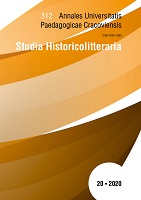Od „śmierdzącego dudka” po banialuki. Obraz ptaków w literaturze renesansu i baroku – rekonesans
From ‘smelly hoopoe’ to baloney. The image of birds in the literature of Renaissance and Baroque – a reconnaissance
Author(s): Dariusz ChemperekSubject(s): Cultural history, Polish Literature, 16th Century, 17th Century, Theory of Literature, Sociology of Literature
Published by: Wydawnictwo Uniwersytetu Komisji Edukacji Narodowej w Krakowie
Keywords: Birds; Old ¬Polish literature; ornitology; symbolography; hunting;
Summary/Abstract: Birds function in Polish literature of Renaissance and Baroque in three paradigms. Mostly they appear as creatures gifted with a symbolic (allegoric) meaning, seen through the prism of the tradition reaching to Aristotle’s Zoology, Physiologist, and later symbological compendia. The second category is describing birds as food or pests (especially in hunting and agricultural literature). Apart from this ‘practical’ paradigm, there is also a third one: birds as a source of an aesthetic thrill, fascination with them includes both lyricism and a ludic element.The first two categories fit into a more general utilitarian paradigm. Handbooks, trea-ties, sermons, fairy tales, paroemias and animal epigrams showcase birds almost exclu-sively as tools of moral, religious and conventional reflection, or as objects to be obtained and consumed. Interestingly, the symbological activity of the creators does not cease in the Renaissance and Baroque periods, the representatives of avifauna are burdened with new meanings, while the fantastic creatures slowly disappear from the creators’ fields of view. In the third group of works distinguished here, one can notice the phenomenon of the eman-cipation of birds as objects of interest just as they are, although their voice is heard mostly in the digressions scattered throughout the big epic works. The autonomy of birds in the literature of Renaissance and Baroque is not linear, the way of perceiving them is deter-mined by the individual sensitivity of the authors, the most prominent of whom are Hieronim Morsztyn (early 17th century) and an anonymous translator of the Italian Adon (2nd half of the 17th century).
Journal: Annales Universitatis Paedagogicae Cracoviensis. Studia Historicolitteraria
- Issue Year: 2020
- Issue No: 20
- Page Range: 76-96
- Page Count: 21
- Language: Polish

